On View
Dutch Artist Joep van Lieshout Created a Failed Utopian Commune in Rotterdam. Now He’s Trying Again—Sort of—in New York
Pioneer Works is hosting the largest exhibition of his work in the US to date.
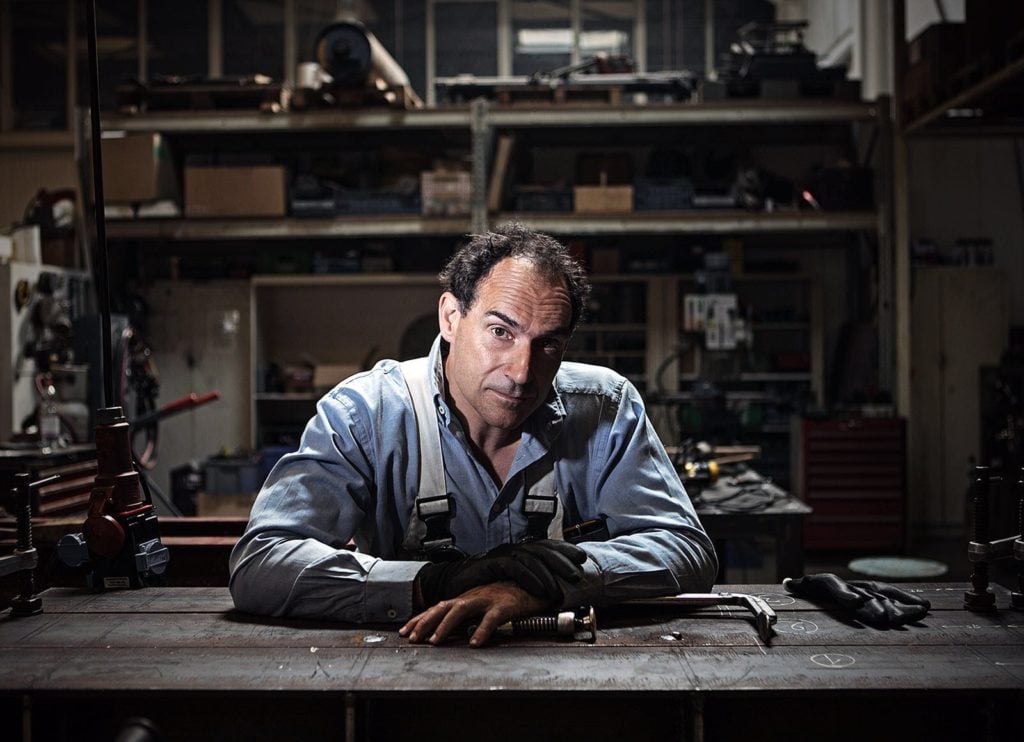
Pioneer Works is hosting the largest exhibition of his work in the US to date.

Caroline Goldstein

What would it be like to give up your phone, your internet access, anything in the way of luxury or comfort, and to move off the grid? How might this (hopefully) simpler place work? Could people live as a communal unit, work towards common goals, live off of cleaner energy, make cleaner food, and pay one another in sex?
These are the questions that Dutch artist Joep van Lieshout has been puzzling over for the past few decades, and answering—at least in part—through his large-scale sculptures, machines, and real-life communal-living experiments.
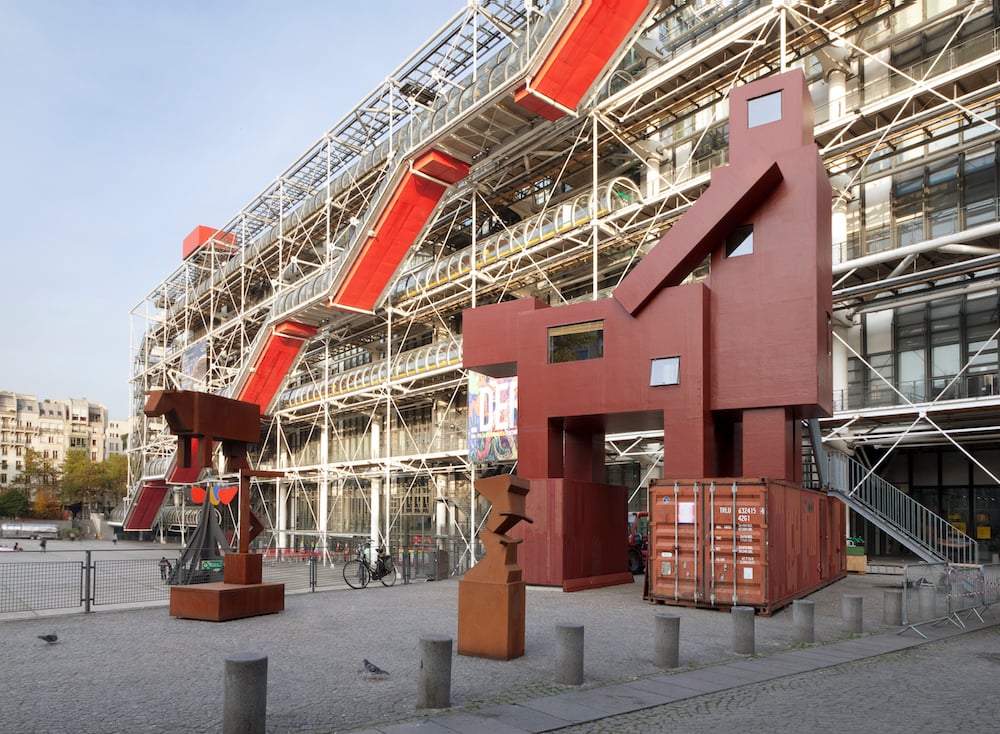
Atelier Van Lieshout’s Domestikator at the Centre Pompidou. Photo Jean-Pierre Vaillancourt for Carpenters Workshop Gallery.
Most Americans probably aren’t too familiar with van Lieshout, who has his largest US show to date on view now at Pioneer Works in Brooklyn. The artist has made more of a name for himself in Europe, where he has been working with Dutch design brands such as Moooi and Lensvelt.
But he has made some inroads in the US. His work is included in the tearjerker blockbuster film The Fault in Our Stars; has been presented in shows at the Carpenters Workshop Gallery; and is collected by celebrities like Brad Pitt, who in 2009 purchased the artist’s Mini Capsule Hotel after seeing it at Design Miami. Kanye West was reportedly in talks with the artist about a possible collaboration last year.
Van Lieshout was born in Ravenstein, the Netherlands, in 1963 and had an auspicious start; when he was just 16, he was accepted to the Academy of Modern Art in Rotterdam. But he’s not interested in the myth of solitary artistic genius. In 1995, he founded the Atelier van Lieshout (the name he still works under) as a way to work with others. Unlike other contemporary artists who have huge numbers of fabricators and assistants, but who take all the credit (Jeff Koons, we’re looking at you), van Lieshout has no pretense about sole ownership.
“He’s always looking at the art world, and looking to create something that is or could be unlimited,” the Brooklyn show’s co-curator, Natalie Kovacs, said at a preview ahead of the exhibition’s opening. “He thinks all art should be on equal footing.”
Most of his work—whether architecture, fine art, or design—is produced in multiples to make it as accessible as possible. He even publishes step-by-step instruction manuals for DIY enthusiasts looking to build their own artworks and furniture.
There is a constant theme of transgression in all of Atelier van Lieshout’s work, and conflicting ideas about utility and extravagance. In 1994, Rem Koolhaas commissioned the artist to design the toilets and wash-stands at the Grand Palais in Lille, and van Lieshout has also made several large-scale public artworks that range from bawdy to banal. His massive sculpture Domestikator was refused by the Louvre in 2017 for its overtly sexual tone (it looks, to some viewers anyway, like two buildings having sex).
But he is also interested in the canon. One of the first works you encounter upon entering Pioneer Works is a rendering of one of the great masterpieces of Etruscan sculpture: the Sarcophagus of the Spouses. His free-standing sculptures and design objects nod to Henry Moore, Diego Giacommetti, and Constantin Brancusi, while his use of polyester and foam calls to mind the soft sculptures of Claes Oldenburg. And he’s a fan of Joseph Beuys, Bruce Nauman, and Paul McCarthy (especially his early works), but “I’m obsessed by my own stuff,” van Lieshout says. “And it’s always been that way.”
Then there are his autarkic society projects.
In 2001, Atelier van Lieshout formed AVL-Ville, a self-proclaimed “free state” erected in Rotterdam’s harbors where van Lieshout and members of his collective lived and worked. The state had its own constitution, flag, and currency, all designed by van Lieshout. The social experiment lasted for less than a year, during which time members lived not just with the work they produced, but inside them too. The cohort lived in caravans and mobile homes, managed farms and slaughterhouses, had a water purification plant fueled by renewable energy, and produced their own medicine and alcohol.
Like every other utopia in history, this one teetered dangerously close to dystopia. And in the end, red tape suffocated the project when its canteen-cum-food hall, which was meant to be a source of funding, was shut down for not having a permit.
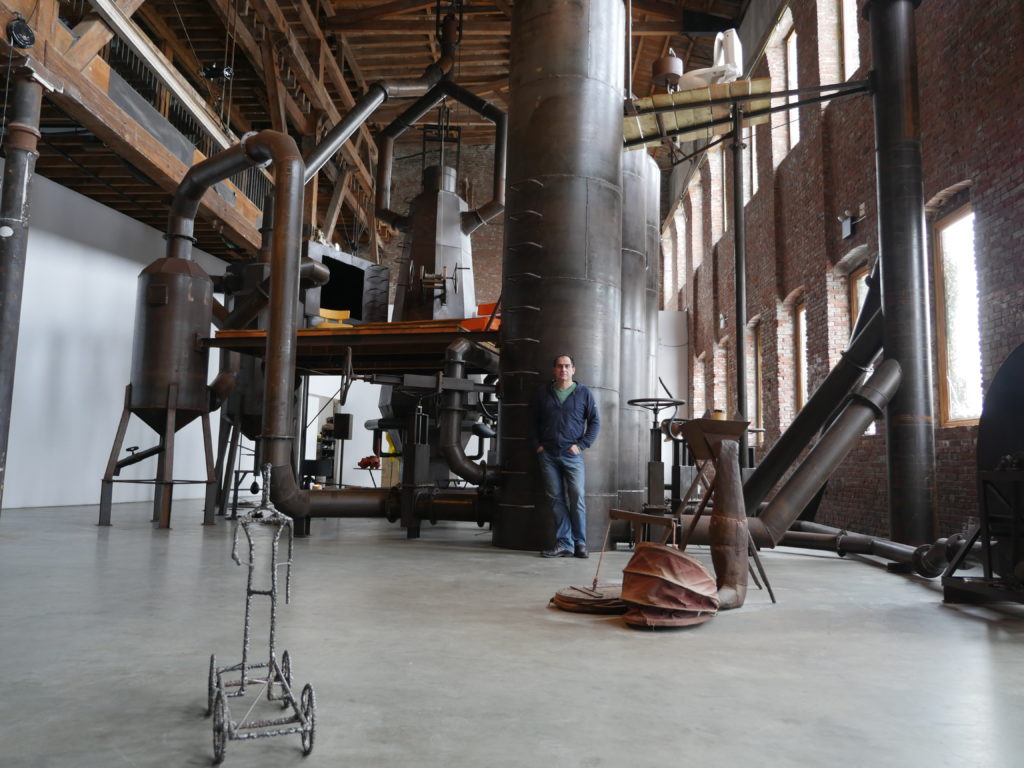
Joep van Lieshout at Pioneer Works. Photo: Natalie Kovacs.
Van Lieshout’s new show at Pioneer Works in Brooklyn, which is titled “The CryptoFuturist and The New Tribal Labyrinth,” features more than 30 works created over the past three decades. The title references two distinct bodies of work: the “CryptoFuturist” series, inspired by the 20th-century Italian Futurist movement, which exalted technological development and the rise of industry; and the “New Tribal Labyrinth,” a fictional narrative that envisions a neo-Industrial Revolution. Together, the two themes say a lot about van Lieshout’s work and personality.
“I think he is the CryptoFuturist,” says Kovacs, who spent the better part of the last four years working towards this show with co-curator Gabriel Florenz. “But on the other hand, he has this romantic longing with ‘The New Tribal Labyrinth’ works. He started this project as a return to industry, farming, and agriculture. Those are the three pillars of the work. He wants you to get off your phone and get to work.”
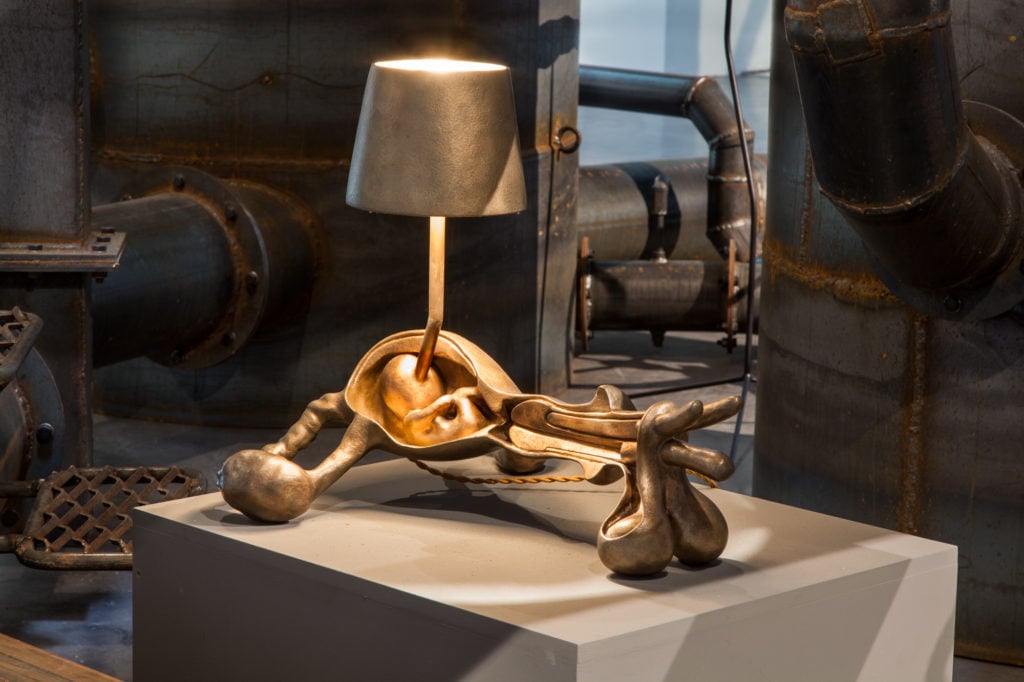
Atelier van Lieshout, Pappamamma Lamp (2009). © 2019 Ateleier van Lieshout.
That eclectic tendency comes across at Pioneer Works. Van Lieshout’s admiration for the 18th-century Christian Shakers, who were known for their spare and elegant furniture, drove him to design simple, straight-backed chairs, which he has paired with Pappamamma Lamp, a bulbous bronze cradle adorned with male and female sex organs flanking a fetus curled up in utero. The light fixture emerges from the child’s head like a massive antenna. The tensions between the sacred and the profane, life and death, the beginning and the end, are all on view, cheek to jowl, despite their antimony.
Then there are pieces like Chicken of the Future and Food Reaktor, which are propositions for future sustainability. According to the artist’s studio, Chicken of the Future solves the problem that, while we all want eggs, “we don’t want to torture cuddly chickens.” Thus, the food of the future is a non-sentient, genetically-modified organism, pared down to its most useful organs. Similarly, Food Reaktor is a farm of the future described as “a stomach on legs” that can mix organic matter with human waste to produce food.
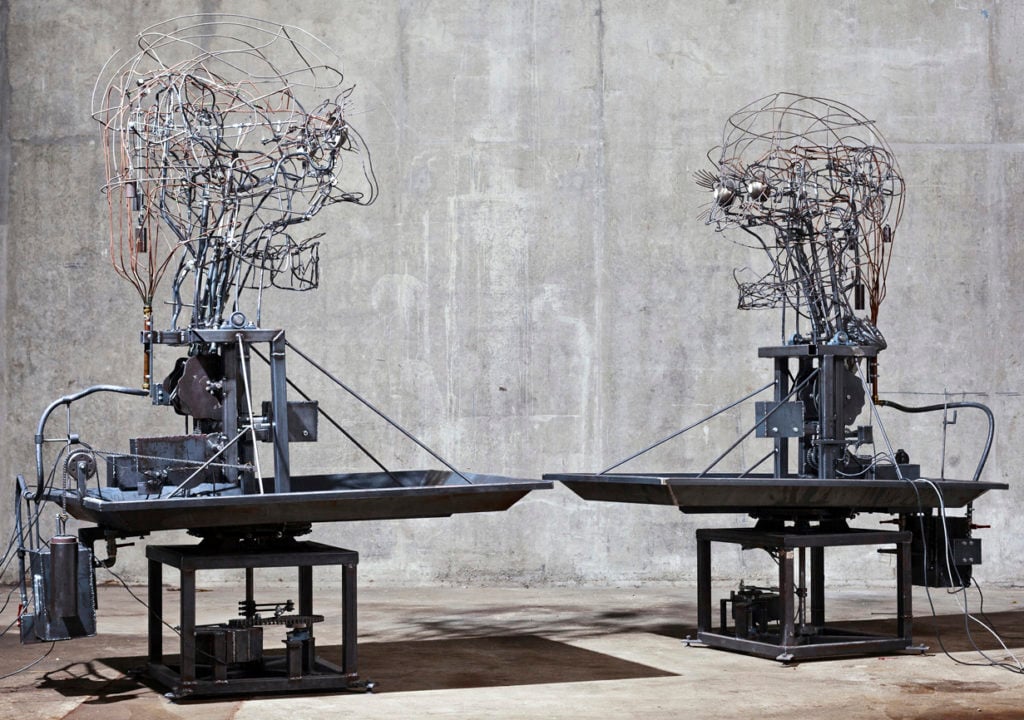
Atelier van Lieshout, The Mechanical Turks (2015). Photo courtesy of AVL and Pioneer Works.
But it’s not all harmony in van Lieshout’s world. There is real tension in a work like The Mechanical Turks, where two massive exoskeleton heads speak at one another, jerking back and forth on their rails. These bickering objects are the ego and the id, the angel and the devil; one is interested only in pleasure and destruction—the “caveman” according to van Lieshout—while the other wonders aloud about the future of society, worrying about global warming and the rise of fascism.
But the piece de resistance of the show is a massive sculpture titled Blast Furnace (2013): a metal and wood contraption based on the design of bygone furnaces used to make steel. It looks like a tree house set on some steel structure, with stairs leading up to staggered platforms. There are places to work, nooks to sleep, and even a toilet way up high, which would allow for human waste to be used as renewable energy.
“He’s sort of a mad scientist,” Kovacs says of van Lieshout. “I think he could re-emerge as the artist of our time. People just don’t realize it yet.”
“The CryptoFuturist and The New Tribal Labyrinth” is on view at Pioneer Works, 159 Pioneer Street, Brooklyn, through April 14.